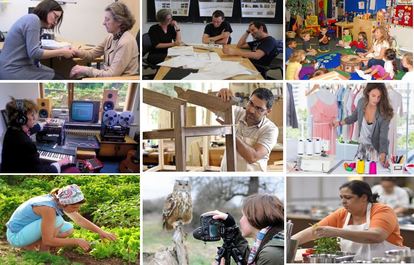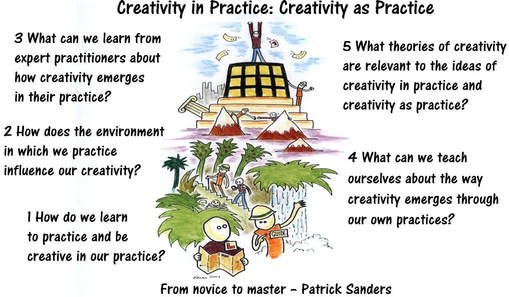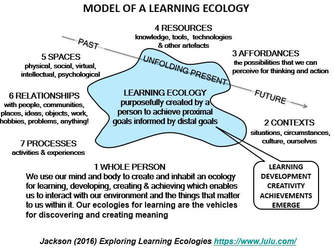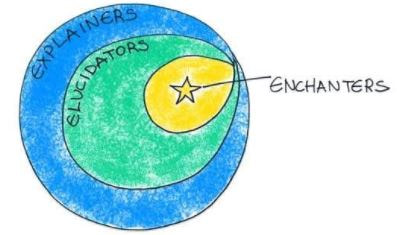
Its time for another conversation about creativity on the #creativeHE platform This one is focused on the relationship between personal creativity and personal practice and it will launch our year long project on the same theme.
Being creative and producing a creative artefact or performance means different things in different practice settings as people interact with their environment and everything in it to achieve something of value. By ‘practice’ we mean ‘action rather than [just] thought or ideas’1, ‘the application or use of an idea, belief, or method, as opposed to theories relating to it for example, the practice of teaching.’2 The term ‘practice’ does not have to be restricted to professional activity it can also be used to describe the actions and activities relating to a person’s hobbies and interests, being a parent and many other contexts.
Exploring my own practices
I will use my blog to explore these ideas in my own practices, particularly those relating to the facilitation of this particular conversation. But what does facilitation mean in this context? Firstly it means making it happen, by having an idea around which the what will happen can form, knowing what has to be done to make it happen and then doing the things to make it happen. These things that make it happen begin well before the conversation itself begins. They involve preparing and helping to establish good conditions so that conversation can happen. 'Making it easier to participate in the conversation' by removing things that get in the way. Nurturing and encouraging things that enable conversation to flourish, helping participants see and appreciate what is important (although everyone will draw their own meaning) and eventually doing things that enable the most important aspects of the conversation to be preserved / curated.
Every #creativeHE conversation provides an opportunity to engage in and practice the practices I have developed over several previous iterations of #creativeHE conversations. So what are these practices?
The will to practice - You cannot have intentional and deliberate action (practice) without the will to engage in such action and that will is linked to some distal goal or long term vision. My interest in the idea of creativity in practice has grown out of my interest in learning ecologies, ecologies for creativity and ecologies of practice. It seems logical to relate practice to the environment in which it is situated and motivated. Every year in July-August I undertake a review for Creative Academic and try to identify the themes we should try to explore in the coming year. The idea of creativity in practice emerged from this reflective process and was discussed with other members of the Creative Academic team. The possibility of a discussion on the #creativeHE platform with the owner Chrissi Nerantzi although we did not fix the date until November.
Finding and creating artefacts for mediation - In October, when visiting my mother in Australia, I spent time writing an article to illustrate how creativity might feature in the practice of a field geologist making a geological map. This was a role I performed in the early part of my career that I could relate to so, it was a form of preparation for engaging. I intended to use it as a mediating artefact to explain to others the sort of narratives that would be useful to develop to represent an ecology of practice in different roles. I knew I could use it in a similar way in my facilitation of a #creativeHE conversation.
Creating the infrastructure/resources In the weeks leading up to the #creativeHE conversation I spent time searching for published research that might inform our discussions and found several articles, and a PhD thesis that were relevant. I emailed several authors and invited them to join our project and conversation.
In the week before the #creativeHE conversation I searched for, watched and evaluated video clips that I could use to stimulate thinking and discussion. I also created a couple of ‘posters’ (right) that showed lots of practices – relating to work, hobbies and interests. I attached these to posts I made.
Being creative and producing a creative artefact or performance means different things in different practice settings as people interact with their environment and everything in it to achieve something of value. By ‘practice’ we mean ‘action rather than [just] thought or ideas’1, ‘the application or use of an idea, belief, or method, as opposed to theories relating to it for example, the practice of teaching.’2 The term ‘practice’ does not have to be restricted to professional activity it can also be used to describe the actions and activities relating to a person’s hobbies and interests, being a parent and many other contexts.
Exploring my own practices
I will use my blog to explore these ideas in my own practices, particularly those relating to the facilitation of this particular conversation. But what does facilitation mean in this context? Firstly it means making it happen, by having an idea around which the what will happen can form, knowing what has to be done to make it happen and then doing the things to make it happen. These things that make it happen begin well before the conversation itself begins. They involve preparing and helping to establish good conditions so that conversation can happen. 'Making it easier to participate in the conversation' by removing things that get in the way. Nurturing and encouraging things that enable conversation to flourish, helping participants see and appreciate what is important (although everyone will draw their own meaning) and eventually doing things that enable the most important aspects of the conversation to be preserved / curated.
Every #creativeHE conversation provides an opportunity to engage in and practice the practices I have developed over several previous iterations of #creativeHE conversations. So what are these practices?
The will to practice - You cannot have intentional and deliberate action (practice) without the will to engage in such action and that will is linked to some distal goal or long term vision. My interest in the idea of creativity in practice has grown out of my interest in learning ecologies, ecologies for creativity and ecologies of practice. It seems logical to relate practice to the environment in which it is situated and motivated. Every year in July-August I undertake a review for Creative Academic and try to identify the themes we should try to explore in the coming year. The idea of creativity in practice emerged from this reflective process and was discussed with other members of the Creative Academic team. The possibility of a discussion on the #creativeHE platform with the owner Chrissi Nerantzi although we did not fix the date until November.
Finding and creating artefacts for mediation - In October, when visiting my mother in Australia, I spent time writing an article to illustrate how creativity might feature in the practice of a field geologist making a geological map. This was a role I performed in the early part of my career that I could relate to so, it was a form of preparation for engaging. I intended to use it as a mediating artefact to explain to others the sort of narratives that would be useful to develop to represent an ecology of practice in different roles. I knew I could use it in a similar way in my facilitation of a #creativeHE conversation.
Creating the infrastructure/resources In the weeks leading up to the #creativeHE conversation I spent time searching for published research that might inform our discussions and found several articles, and a PhD thesis that were relevant. I emailed several authors and invited them to join our project and conversation.
In the week before the #creativeHE conversation I searched for, watched and evaluated video clips that I could use to stimulate thinking and discussion. I also created a couple of ‘posters’ (right) that showed lots of practices – relating to work, hobbies and interests. I attached these to posts I made.

I redesigned the existing #creativeHE conversations and courses web page on the Creative Academic website which provided the resources page and updated it each day of the conversation. I created a rough plan for the conversation: it can only ever be rough!. I also created an infographic to provide an overview of the main questions that would help us explore this subject.
Promotion - You can't have a conversation without people and my biggest fear and challenge is to involve enough people, and enough different people to enable the conversation to happen. I have the belief that the people who become involved conduct the conversation on behalf of everyone else and I hope for a critical mass of at least 10 people. About two weeks before the #creativeHE conversation I started to promote the conversation. I contacted, by email, a number of people who regularly participate in #creativeHE conversations to invite them, and used several mail lists to circulate a notice. I also made a number of posts in groups on Linked-in to try and stimulate interest. Two days before the conversation was due to start I made several posts on twitter copied to #creativity #practice and #creativepractice. Past experience has shown me that it is important to start engaging potential participants before the official start of an on-line conversation so, three days before the conversation began I made an introductory post on the #creativeHE forum linking it to an article about an action theory of creativity (one of my mediating artefacts).
Promotion does not end when the conversation starts: it continues right through to the end. On the first day I established a routine - 1) make the daily post on #creativeHE forum by 8am 2) post the theme of the day on twitter and linked-in with invitations 3) throughout the day check regularly each of these sites and respond.
Engagement - once the conversation started my focus switched to engaging participants. Following my initial daily post made by 8am each morning, I checked the conversation every couple of hours and to respond to any comments or posts, while trying to make further connections to the key questions.
Self-awareness and reflection - In past #creativeHE conversations I have found it very useful to keep a blog to record my own involvement and learning. It's the way I make myself accountable to myself and participants. So, two days before we started the conversation I thought about my own practice in preparing for the conversation and wrote this post. In writing it I created another mediating artefact to explain to myself and others what we are trying to explore.
Curation - I feel that the facilitator of an on-line conversation should also be a curator, organising, synthesising and making available the content to participants and the wider public who might be interested. In the past this has been a post-conversation activity but on day 1, because of the small number of contributors, I could accomplish this role while the conversation was in progress. I decided to use my blog as the medium for curation. The discipline of writing the blog at the same time as facilitating enabled me to draw more meaning from the conversation.
Promotion - You can't have a conversation without people and my biggest fear and challenge is to involve enough people, and enough different people to enable the conversation to happen. I have the belief that the people who become involved conduct the conversation on behalf of everyone else and I hope for a critical mass of at least 10 people. About two weeks before the #creativeHE conversation I started to promote the conversation. I contacted, by email, a number of people who regularly participate in #creativeHE conversations to invite them, and used several mail lists to circulate a notice. I also made a number of posts in groups on Linked-in to try and stimulate interest. Two days before the conversation was due to start I made several posts on twitter copied to #creativity #practice and #creativepractice. Past experience has shown me that it is important to start engaging potential participants before the official start of an on-line conversation so, three days before the conversation began I made an introductory post on the #creativeHE forum linking it to an article about an action theory of creativity (one of my mediating artefacts).
Promotion does not end when the conversation starts: it continues right through to the end. On the first day I established a routine - 1) make the daily post on #creativeHE forum by 8am 2) post the theme of the day on twitter and linked-in with invitations 3) throughout the day check regularly each of these sites and respond.
Engagement - once the conversation started my focus switched to engaging participants. Following my initial daily post made by 8am each morning, I checked the conversation every couple of hours and to respond to any comments or posts, while trying to make further connections to the key questions.
Self-awareness and reflection - In past #creativeHE conversations I have found it very useful to keep a blog to record my own involvement and learning. It's the way I make myself accountable to myself and participants. So, two days before we started the conversation I thought about my own practice in preparing for the conversation and wrote this post. In writing it I created another mediating artefact to explain to myself and others what we are trying to explore.
Curation - I feel that the facilitator of an on-line conversation should also be a curator, organising, synthesising and making available the content to participants and the wider public who might be interested. In the past this has been a post-conversation activity but on day 1, because of the small number of contributors, I could accomplish this role while the conversation was in progress. I decided to use my blog as the medium for curation. The discipline of writing the blog at the same time as facilitating enabled me to draw more meaning from the conversation.

My unfolding ecology of practice
So what does this reveal about my practice? The first thing it reveals to me is that there is both a history to my practice and an unfolding present. I facilitated my first #creativeHE conversation two years ago and since then I have been involved in five other conversations. My practice has been learnt through experiment and experience, and by observing others. I have, and will, also drawn upon practices I use in other aspects of my work. My unfolding present involves me in executing my rough plan and refining the detail as I go, and also responding to what emerges as I interact with the posts people make in the Google+ forum. As leader of the conversation I try to respond to every post and open up further discussion. This aspect of practice cannot be predicted so there is an element of going with the flow and it is in this dynamic where new possibilities for practice emerge.
My second observation is that my practice follows the general pattern I have established for a learning ecology (right). There is a context – the work of Creative Academic and #creativeHE to facilitate the sharing and development of knowledge about creativity and this creates the purpose that relates to serving our communities of interest. I recognize the affordance in the #creativeHE platform and network to share ideas and experiences and learn. I interact with my environment and myself to find and create resources that can be used in a process that I will eventually facilitate. We are utilising a particular virtual space for the conversation, in the form of the #creativeHE platform and working with the affordances and constraints of that space. My initial practices must envision and prepare for the process I will try to facilitate that will enable a conversation to unfold. I have begun to develop new relationships to draw in people with particular knowledge and insights and have utilized existing relationships to develop the conditions that will enable and sustain the conversation. I have always thought that the way you contact people out of the blue via email is so important to gaining their interest, trust and involvement. I put a lot of effort into crafting emails to try and achieve this. I have begun the process of documenting and reflecting on my experience through my blog in order to record and learn.
So what does this reveal about my practice? The first thing it reveals to me is that there is both a history to my practice and an unfolding present. I facilitated my first #creativeHE conversation two years ago and since then I have been involved in five other conversations. My practice has been learnt through experiment and experience, and by observing others. I have, and will, also drawn upon practices I use in other aspects of my work. My unfolding present involves me in executing my rough plan and refining the detail as I go, and also responding to what emerges as I interact with the posts people make in the Google+ forum. As leader of the conversation I try to respond to every post and open up further discussion. This aspect of practice cannot be predicted so there is an element of going with the flow and it is in this dynamic where new possibilities for practice emerge.
My second observation is that my practice follows the general pattern I have established for a learning ecology (right). There is a context – the work of Creative Academic and #creativeHE to facilitate the sharing and development of knowledge about creativity and this creates the purpose that relates to serving our communities of interest. I recognize the affordance in the #creativeHE platform and network to share ideas and experiences and learn. I interact with my environment and myself to find and create resources that can be used in a process that I will eventually facilitate. We are utilising a particular virtual space for the conversation, in the form of the #creativeHE platform and working with the affordances and constraints of that space. My initial practices must envision and prepare for the process I will try to facilitate that will enable a conversation to unfold. I have begun to develop new relationships to draw in people with particular knowledge and insights and have utilized existing relationships to develop the conditions that will enable and sustain the conversation. I have always thought that the way you contact people out of the blue via email is so important to gaining their interest, trust and involvement. I put a lot of effort into crafting emails to try and achieve this. I have begun the process of documenting and reflecting on my experience through my blog in order to record and learn.

Where is my creativity in all this?
In the lead up to the online event I would not make claims about being creative other than perhaps through the writing of my narrative – ‘an ecology of practice making a geological map’, which I will use as a mediating artefact. Writing is the most important medium I use to express myself and I think the making a geological map article is an example of how I use my own life to explore and develop theories of learning in contexts that I understand. I also enjoy producing infographics that help to explain and elucidate complex ideas. Creating pictures often annotated, is another important medium for my self-expression.
While I was writing this post I came across this infographic on twitter from Maria Popova 'Brain Picker' one of the very best disseminators of wisdom on the internet. The simplicity of design and power of the message 'enchanted' me and I had never thought about the role of illustrations in this way before. It articulated in a clever way the truth that a good illustration or infographic not only communicates and explains ideas but it captures attention in an emotional way - it enchants or inspires us to think differently or more deeply about something. It shares wisdom not just information.
I will continue to develop the story of my ecology of practice during the #creativeHE conversation between Dec4-8th
Sources
1 Cambridge Dictionary available at https://dictionary.cambridge.org/dictionary/english/practice
2 Oxford Dictionary available at https://en.oxforddictionaries.com/definition/practise
Posted 02/12 revised 04/12, 05/12
In the lead up to the online event I would not make claims about being creative other than perhaps through the writing of my narrative – ‘an ecology of practice making a geological map’, which I will use as a mediating artefact. Writing is the most important medium I use to express myself and I think the making a geological map article is an example of how I use my own life to explore and develop theories of learning in contexts that I understand. I also enjoy producing infographics that help to explain and elucidate complex ideas. Creating pictures often annotated, is another important medium for my self-expression.
While I was writing this post I came across this infographic on twitter from Maria Popova 'Brain Picker' one of the very best disseminators of wisdom on the internet. The simplicity of design and power of the message 'enchanted' me and I had never thought about the role of illustrations in this way before. It articulated in a clever way the truth that a good illustration or infographic not only communicates and explains ideas but it captures attention in an emotional way - it enchants or inspires us to think differently or more deeply about something. It shares wisdom not just information.
I will continue to develop the story of my ecology of practice during the #creativeHE conversation between Dec4-8th
Sources
1 Cambridge Dictionary available at https://dictionary.cambridge.org/dictionary/english/practice
2 Oxford Dictionary available at https://en.oxforddictionaries.com/definition/practise
Posted 02/12 revised 04/12, 05/12
 RSS Feed
RSS Feed